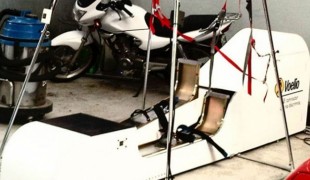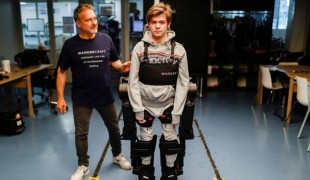- 9115
- 321
- 17
- 15
- 0
- Help Ukraine
About the solution
Cambry Kaylor was left paralyzed following an equestrian vaulting accident in 2005. Following her accident, her then-boyfriend, Zack Nelson, spliced together two electric bicycles with a seat in the center. He wanted to build her something that could give her a sense of freedom – something she missed since her accident. Once she became accustomed to her new gift, she found that she could finally move around the way she wanted.
A year later, in 2006, Kaylor and Nelson were married. They teamed up to start working on mass-producing Nelson’s original invention. They founded the company, Not-a-Wheelchair, and began building their first product – The Rig, an adaptive off-road wheelchair constructed using bicycle parts. In addition to providing additional mobility, the product also features a rear rack mounting system to hold wheelchairs, coolers, and other hiking and camping equipment.
The couple kept working together to perfect The Rig, but they weren’t making much progress. “The toughest challenge when developing ‘The Rig’ is the price. We wanted to create something that is affordable for everyone. Finding quality components and a simple enough design at the cheapest price possible took quite a bit of time,” Nelson commented. “But I think we have something now that everyone will be able to enjoy, at a fraction of the cost of other off-road wheelchairs that are currently on the market.”
In addition, another obstacle is that the product requires the normal maintenance needs of a regular bicycle – which could seriously dissuade buyers from purchasing.
To test the product, Cambry and Nelson went on various trips together. They brought the special wheelchair to Hawaii to see how it performed in rocky terrain. They have also tested the bicycle on mountains and snowy trails.
Currently, The Rig can travel up to 12 miles-per-hour and it has a range of 10 to 20 miles with only one battery. It can travel up to 25 to 35 miles with two batteries, but there are restrictions depending on the terrain, weight of the rider (up to 225 pounds), and the weight of the cargo. The off-road wheelchair is truly an altogether unique vehicle for handicapped individuals.
“Our whole goal is to provide something that is capable and affordable,” the couple commented. They knew that there were limited options for handicapped individuals; and from their experience, the bicycles that were already available were either too costly or too slow. They worked together to create the perfect bicycle but many challenges stood in the way.
Adapted from: https://notawheelchair.com/products/the-rig, https://www.icepop.com/husband-invents-off-road-wheelchair-for-wife/
https://youtu.be/vuMg0QwKAGI
This solution shall not include mention to the use of drugs, chemicals or biologicals (including food); invasive devices; offensive, commercial or inherently dangerous content. This solution was not medically validated. Proceed with caution! If you have any doubts, please consult with a health professional.
DISCLAIMER: This story was written by someone who is not the author of the solution, therefore please be advised that, although it was written with the utmost respect for the innovation and the innovator, there can be some incorrect statements. If you find any errors please contact the patient Innovation team via info@patient-innovation.com
-
-
613
-
0
-
9896

Multiple sclerosis patient develops map to help people with disabilities
CAREGIVING
MOVING IN A WHEELCHAIR: Moving using a wheelchair.
WALKING WITH A WALKING AID: Walking with a walking aid
WALKING: Walking
Multiple Sclerosis
Website
App (Including when connected with wearable)
Restoring mobility
Enhancing health literacy
Promoting self-management
Rehabilitating After Stroke
Managing Neurological Disorders
Building Supportive Community Relationships
Promoting inclusivity and social integration
Recovering from Traumatic Injuries
Enhancing Mental Health
Raise awareness
Caregiving Support
General and Family Medicine
Internal Medicine
Neurology
Neurosurgery
Physical Medicine and Rehabilitation
United States
-
-
-
513
-
0
-
9088

Father creates walking aid for his son
WALKING: Walking
WALKING WITH A WALKING AID: Walking with a walking aid
CAREGIVING
Cervical spinal cord injury/Tetraplegia
Walking Aid (wheelchair/walker/crutches)
Restoring mobility
Promoting self-management
Preserving Organ Function
Rehabilitating After Stroke
Managing Neurological Disorders
Recovering from Traumatic Injuries
Maintaining Balance and Mobility
To improve Treatment/Therapy
Raise awareness
Caregiving Support
General and Family Medicine
Internal Medicine
Neurology
Pediatrics
Physical Medicine and Rehabilitation
Argentina
-
-
-
401
-
0
-
5618

Father creates exoskeleton to help son with genetic neurological condition walk
BODY BALANCE: Maintaining body balance
STANDING UP: Standing up from a seated position
WALKING WITH A WALKING AID: Walking with a walking aid
CAREGIVING
Cervical spinal cord injury/Tetraplegia
Assistive Technology access
Walking Aid (wheelchair/walker/crutches)
Restoring mobility
Managing pain
Promoting self-management
Preserving Organ Function
Managing Neurological Disorders
Recovering from Traumatic Injuries
Maintaining Balance and Mobility
Restoring Blood Circulation
To improve Treatment/Therapy
Preventing (Vaccination, Protection, Falls, Research/Mapping)
Raise awareness
Caregiving Support
General and Family Medicine
Intensive Care Medicine
Neurology
Physical Medicine and Rehabilitation
Sports Medicine
France
-
 en
en